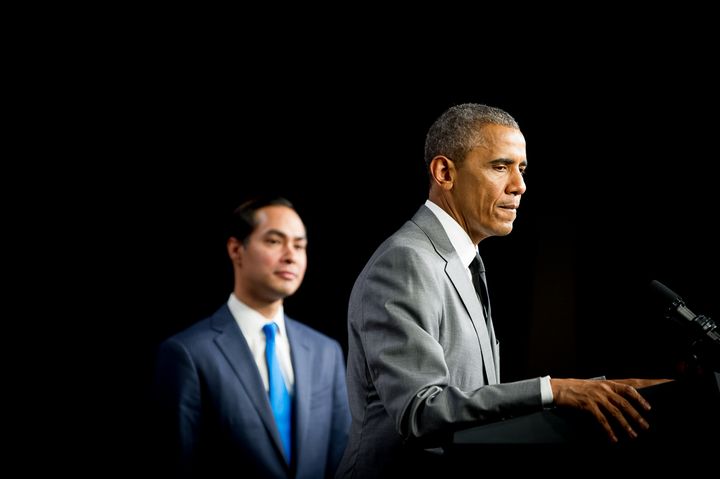
President Obama with Housing Secretary Julián Castro at the Department of Housing and Urban Development on July 31, 2014.
Only days after the Trump Administration declared plans to dismantle affirmative action in universities, Trump unlawfully suspended the mandatory implementation of an Obama-era rule that addressed segregation in Section 8 housing. Trump gave housing authorities the choice to continue voluntarily implementing the rule. San Diego announced that it was voluntarily choosing to follow Trump’s segregation efforts because it considered the Obama-era policy to be “nothing more than social engineering.”
The Section 8 De-Segregation Rule
The rule was an attempt by the Obama Administration to address the nation’s housing segregation crisis. Segregation levels today mirror those that existed in the 1960s.[1] The resegregation of communities is a crisis exacerbated in metropolitan areas, like San Diego, where vouchers are accepted only in low-opportunity, high-poverty neighborhoods, if at all. Nationally, only 15% of children in families that receive housing subsidies live in low-poverty areas; the vast majority of these children live in very poor, segregated neighborhoods.[2] One in three (35%) vouchers in San Diego goes to a family with children.[3]
The rule changed the way 23 segregated metropolitan areas issued vouchers to low-income tenants. The rule directed the metropolitan areas to use a rent standard that is determined by small area (zip code) fair market rents, instead of metropolitan-wide fair market rents. The metropolitan areas were selected by the Obama Administration because of their high concentration of voucher tenants living in high-poverty/low-income neighborhoods.[4]
The goal was simple: improve the health of low-income families by increasing access to lower poverty and higher opportunity areas. The method chosen - Small Area Fair Market Rents - was evidence-based and had been proven effective at de-segregating and de-concentrating poverty.
President Obama’s Implementation of the Rule
Prior to the mandatory implementation of the rule, the Obama Administration conducted extensive research on ways to address the increasing levels of segregation and concentrations of housing vouchers in high-poverty areas. Evidence from a demonstration project in Texas (the result of a court settlement – HUD was sued for its willingness to accept racial segregation in Dallas) suggested that the small area fair market rent model may be less costly and more effective than other voucher interventions at de-concentrating families with vouchers from high-poverty, high-crime neighborhoods.
Pursuant to federal law (the Administrative Procedures Act, which is at issue in the current lawsuit against Trump’s suspension of the rule), the Obama Administration invited public comment before finalizing the rule. Poverty lawyers across the nation shared their expertise, concerns, and requests (including a hold harmless provision) to ensure that the rule addressed the administration’s goals while protecting the rights of low-income tenants.
Modifications were made and the rule was finalized on August 16, 2016.
Trump Unlawfully Suspends Obama-Era De-Segregation Rule
On August 11th, Trump issued a letter suspending the mandatory implementation of the rule.
The suspension happened only days after Trump announced plans to identify and target universities using affirmative action. Justification for the suspension of the rule was not provided, but on August 15th, HUD released an Interim Report that evaluated SAFMRs in demonstration projects. The HUD-commissioned report did not provide information to counter the effectiveness of the policy nor did it raise concerns that were not already raised during the Obama-era public comment period. If this report was in fact the motivation for suspending the rule, the rule could have been amended or HUD could have implemented guidance for the rule to address the concerns. Suspending the rule was not necessary.
The true motivation for the suspension of the rule may be part of an across-federal agency effort to undermine and dismantle de-segregation efforts.
Moreover, the suspension of the rule was unlawful. Federal administrative procedures were not followed. Opportunity for public comment was not provided. Federal housing law was violated by the undermining of racial de-segregation efforts.
San Diego’s Decision to Follow Trump Segregation Efforts
One week after Trump suspended the rule, San Diego’s housing authority was encouraged to continue implementing Obama-era de-segregation efforts. The housing authority was provided with data supporting the need for de-segregation efforts and the legal basis that allowed the housing authority to move forward with de-segregation efforts. San Diego’s housing authority was encouraged to continue to implement the Obama-era rule since it was not only the right thing to do, it made fiscal sense since San Diego’s housing authority had already spent resources on and planned to implement small area fair market rents (SAFMR).[5]
On August 28th, the CEO of San Diego’s housing authority announced that it was voluntarily choosing to follow Trump’s segregation efforts instead of the Obama-era policy, because it considered the Obama-era policy to be “nothing more than social engineering.”
“it amounted to nothing more than social engineering.” San Diego Housing Commission CEO Rick Gentry on the de-segregation rule.
The CEO of one of the largest housing authorities in the nation attempted to disguise his decision to follow Trump policies by announcing an ill-conceived, short-sighted three-tier rent system to take the place of the Obama-era rule.
The Obama-era SAFMRs de-segregation policy is a nationally recognized, effective evidence-based approach to de-segregating and de-concentrating poverty. A three-tier system would be worse for de-segregation and de-concentration of poverty efforts than SAFMRs. Evidence-based studies show that the reasons SAFMRs are effective is because of the granular nature of the rent calculation.
SAFMRs open up opportunities for families because the assistance level better reflects the market rent than regional fair market rents. With a three-tier system, tenants would run into the same issues as the current system, which blocks low-income families with vouchers from being able to live in high-opportunity, low-poverty areas.
San Diego’s Track Record of Policies that Harm Low-Income Families
Implementing an ill-conceived three-tier rent system instead of an evidence-based nationally recognized policy is extremely concerning given the San Diego housing authority’s track record of creating harmful local policies disguised as being better for tenants.
One example is San Diego’s “Community Choices Program,” which encourages low-income tenants to pay 50% of their income to rent, despite nationwide efforts to limit family rent contributions to 30%.
Another example is its ongoing failure to update its payment standards to reflect current market rents, forcing low-income families to use housing vouchers that are based on 2015 market rents (see here), which makes it impossible to make use of the housing voucher.
And most concerning, San Diego’s “Moving to Work” program, through which the housing authority opted out of following federal laws aimed at protecting low-income housing subsidy recipients.
Open Letter to San Diego Housing Commission CEO Rick Gentry:
While the San Diego City Council may continue to rubber-stamp San Diego housing authority’s policies that adversely impact the low-income tenants that the city receives federal funding to protect, the housing authority should use its power to do the right thing.
There is still time for the San Diego housing authority to protect vulnerable, low-income families by implementing SAFMRs.
Please do right by the 14,000 low-income families in San Diego who rely on vouchers by implementing the Obama-era de-segregation rule with hold harmless provisions. In the interim, please stop forcing low-income families to rely on vouchers that are based on 2015 market rents and update the voucher values to reflect current market rents.
[1] Fiel, Jeremy E. "Decomposing School Resegregation: Social Closure, Racial Imbalance, and Racial Isolation." American Sociological Review. no. 5 (2013): 1-21. (accessed September 24, 2013).
[2]Center on Budget and Policy Priorities, October 2014, “Creating Opportunity for Children: How Housing Location Can Make a Difference” (accessed August 20, 2017).
[3] https://www.huduser.gov/portal/datasets/assthsg.html#2009-2016_query (Data: CA063, HCVP, 2016 based on 2010 Census) (accessed August 20, 2017).
[4] https://www.huduser.gov/portal/datasets/fmr/smallarea/index.html#proposed-rulemaking (FY 2016 Small Area FMRs with HUD Metro FMR Area Designations) (accessed August 20, 2017).
